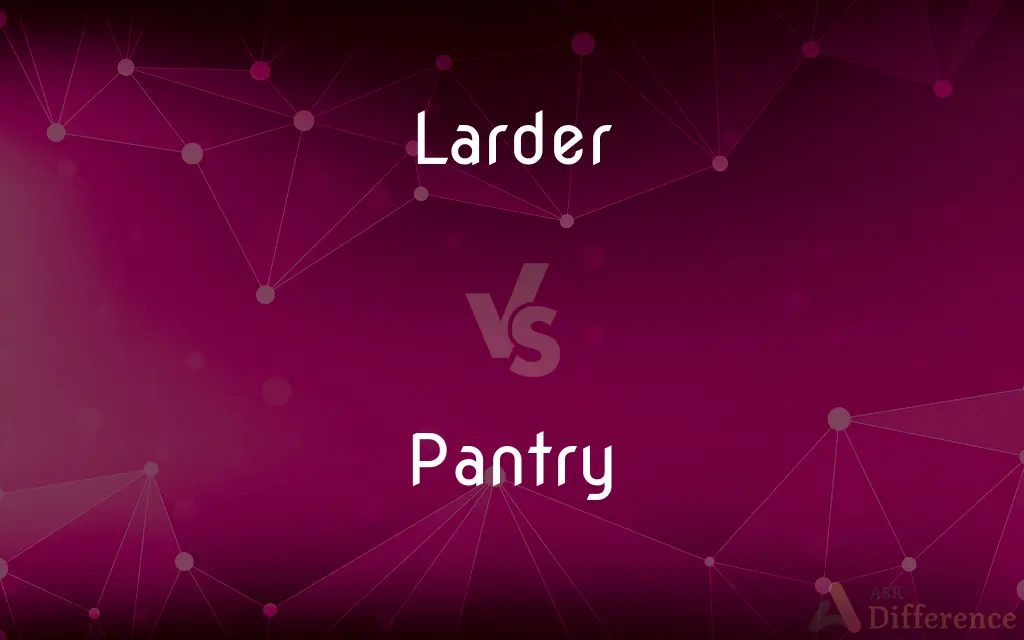Larder vs. Pantry — What's the Difference?
By Maham Liaqat & Fiza Rafique — Updated on March 7, 2024
A larder is a cool area for storing food prior to use, while a pantry is a room or closet where food, dishes, and utensils are kept.

Difference Between Larder and Pantry
Table of Contents
ADVERTISEMENT
Key Differences
Traditionally, a larder refers to a cool place, often separate from the kitchen, where perishable foods like meat, dairy, and vegetables are stored to keep them fresh. Larders were especially common before the widespread use of refrigerators, relying on cooler temperatures and good ventilation to preserve food. In contrast, a pantry is typically a small room or closet adjacent to the kitchen, used for storing non-perishable food items, such as canned goods, grains, spices, and sometimes kitchenware and utensils.
The concept of a larder is often associated with older or more traditional homes and may include features such as stone slabs or shelves to keep the environment cool. Pantries, on the other hand, are more versatile and can be found in modern homes, often featuring built-in shelving and storage solutions for a variety of kitchen essentials.
While the primary function of a larder is to store fresh and perishable foods in a cool environment, a pantry's main role is to organize and store non-perishable food items and other kitchen essentials, making them easily accessible for everyday cooking and food preparation.
In some modern homes, the distinction between a larder and a pantry may blur, with some pantries equipped with refrigeration or cooler sections to store perishables, effectively combining the functions of both. However, the traditional definitions still apply, with larders focusing on the preservation of fresh foods and pantries on the storage of dry goods and kitchen supplies.
The choice between having a larder or a pantry in a home can depend on various factors, including the availability of space, the architectural style of the house, and the homeowners' cooking habits and food storage needs. Some may prefer a larder for its ability to naturally preserve fresh foods, while others might find a pantry more practical for organizing and storing a wide range of kitchen items.
ADVERTISEMENT
Comparison Chart
Primary Use
Storing fresh and perishable foods
Storing non-perishable foods and essentials
Temperature
Cool, to preserve freshness
Room temperature, suitable for dry goods
Location
Often separate from the kitchen
Usually adjacent to or within the kitchen
Storage Items
Meats, dairy, vegetables
Canned goods, grains, spices, utensils
Era
More common in pre-refrigeration times
Found in both traditional and modern homes
Compare with Definitions
Larder
Designed to prolong the shelf life of perishable goods without refrigeration.
Stone slabs in the larder helped keep dairy products cool before the advent of refrigeration.
Pantry
A room or closet for storing non-perishable food items and kitchen essentials.
She organized the pantry, neatly arranging the canned goods and spices on the shelves.
Larder
A cool storage space for fresh and perishable food items.
The larder was stocked with fresh vegetables and cuts of meat, keeping them cool and fresh.
Pantry
Can be located within or adjacent to the kitchen for easy access.
The modern kitchen design included a walk-in pantry for additional storage space.
Larder
Traditionally separate from the kitchen to maintain a cooler temperature.
In older homes, the larder was often located on the north side to keep it away from direct sunlight.
Pantry
Serves as an organizational space for food preparation and meal planning.
With everything neatly labeled in the pantry, meal prep became a much simpler task.
Larder
Used for storing food items that require a cool environment.
The chef kept the freshly harvested herbs in the larder to maintain their freshness.
Pantry
Stores a variety of items, including food, dishes, and cooking utensils.
The pantry was well-stocked with not only food but also extra dishes and baking pans.
Larder
Reflects historical food preservation methods in pre-refrigeration homes.
The estate's large larder was essential for preserving the harvest throughout the year.
Pantry
Adaptable to modern homes, often with custom shelving and storage solutions.
The newly renovated kitchen featured a custom-built pantry with adjustable shelves.
Larder
A larder is a cool area for storing food prior to use. Originally, it was where raw meat was larded—covered in fat—to be preserved.
Pantry
A pantry is a room where beverages, food, and sometimes dishes, household cleaning chemicals, linens, or provisions are stored. Food and beverage pantries serve in an ancillary capacity to the kitchen.
Larder
A place, such as a pantry or cellar, where food is stored.
Pantry
A small room or closet, usually off a kitchen, where food, tableware, linens, and similar items are stored.
Larder
A supply of food.
Pantry
A small room used for the preparation of cold foods.
Larder
A cool room in a domestic house where food is stored, but larger than a pantry.
Pantry
See food pantry.
Larder
A food supply.
Pantry
A small room, closet, or cabinet usually located in or near the kitchen, dedicated to shelf-stable food storage and/or storing kitchenware, like a larder, but smaller.
Larder
A room or place where meat and other articles of food are kept before they are cooked.
Pantry
(Hong Kong) A break room.
Larder
A supply of food especially for a household
Pantry
An apartment or closet in which bread and other provisions are kept.
Larder
A small storeroom for storing foods or wines
Pantry
A small storeroom for storing foods or wines
Common Curiosities
Can a modern home have both a larder and a pantry?
Yes, a modern home can have both, with the larder used for fresh perishables and the pantry for dry goods and kitchen essentials.
How does a pantry differ from a larder in terms of temperature?
A pantry is usually at room temperature and is suitable for storing dry goods, while a larder is kept cool to store perishable items.
What might you find in a traditional pantry?
In a traditional pantry, you might find canned goods, grains, spices, and sometimes kitchenware and utensils for food preparation.
How were larders used before the invention of refrigerators?
Before refrigeration, larders were essential for keeping perishable foods cool and extending their shelf life through natural cooling methods.
Can the terms 'larder' and 'pantry' be used interchangeably?
While they have distinct historical uses, in modern language they are sometimes used interchangeably, especially in regions where one term is more common.
How do you maintain a proper temperature in a larder?
Proper ventilation, insulation, and occasionally using cooling elements like marble or stone can help maintain the temperature in a larder.
What is a butler's pantry and how does it differ from a standard pantry?
A butler's pantry is a space between the kitchen and dining area used for storage and meal prep, often more formal and equipped with sinks and appliances.
Is it common for pantries to have refrigeration units today?
In some modern homes, pantries may include refrigeration units or cooler sections, blurring the line between pantry and larder.
What architectural features might a larder have to keep it cool?
Larders might have features like stone slabs, ventilation for air circulation, and be situated in a part of the house that receives less sunlight.
What is the main purpose of a larder?
The main purpose of a larder is to store fresh and perishable foods in a cool environment to preserve their freshness.
How has the use of pantries evolved in modern kitchens?
Modern pantries have evolved to offer versatile storage solutions, including custom shelving and organizers for a wide range of kitchen and food items.
What are the benefits of having a larder in a contemporary home?
A larder can offer natural cooling for perishables, which is energy-efficient and can enhance the flavor and longevity of fresh foods.
Can a pantry contribute to more efficient kitchen organization?
Yes, a well-organized pantry can greatly contribute to kitchen efficiency by keeping ingredients and utensils accessible and orderly.
How important is ventilation in a larder?
Ventilation is crucial in a larder to maintain cool temperatures and prevent the buildup of moisture, which can lead to spoilage.
How can one modernize an existing pantry or larder?
Modernizing can involve adding shelving, bins, and labels for organization, or installing modern appliances like wine coolers or refrigeration units for perishables.
Share Your Discovery

Previous Comparison
Gear vs. Clothes
Next Comparison
Optimize vs. OptimiseAuthor Spotlight
Written by
Maham LiaqatCo-written by
Fiza RafiqueFiza Rafique is a skilled content writer at AskDifference.com, where she meticulously refines and enhances written pieces. Drawing from her vast editorial expertise, Fiza ensures clarity, accuracy, and precision in every article. Passionate about language, she continually seeks to elevate the quality of content for readers worldwide.















































